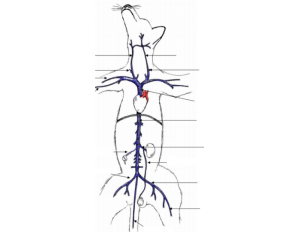PCPR-Lesson 2- Trauma
Trauma can be from blunt force or penetrating objects. Depending on the degree of trauma and the location, these types of injuries can be life-threatening and you should seek veterinary care as soon as possible.
- Head trauma – Fortunately, dogs are very resistant to head trauma due to the large amount of bone/muscle around their brain as compared to people. Signs of head trauma in the dog can include: mental dullness, abnormal behavior, seizures, or unequal pupils. Until you can get to a veterinarian, you can elevated the head about 30 degrees, avoid placing any pressure on the neck, and cool or ice pack the head.
- Chest trauma – can result in bruising to the lungs or leakage of air from the lungs (pneumothorax). Signs can include difficulty breathing, shortness of breath, rapid and shallow breathing, very pale or blue/purple gums and/or tongue. If there is an impalement injury (such as with a stick), do not remove the object if at all possible. Pack around the area for control of bleeding and place a supportive wrap. Use caution to not make chest wraps too tight as they can impede breathing.
- Abdominal trauma – blunt trauma can result in rupture, bleeding, or damage to internal organs. Signs can be subtle and can be delayed for hours, sometimes up to several days. Signs can range from bruising, pain, abdominal distention, shock, weakness, or collapse. Penetrating trauma to the abdomen should be treated similarly to the chest. If tissue is extruding from any wounds, apply lube to keep the tissue moist and cover the area. Any impaled objects should not be removed if possible.
Severe Bleeding

Major arteries in a dog
Arterial bleeding is a serious injury that can cause a large amount of blood to be lost. Because there is such a large amount of blood pressure in an arterial a dog can lose a life threatening amount of blood in just minutes. Initially, attempt to stop the bleeding by applying direct pressure to the wound with an absorbent dressing, such as dry gauze, followed by a layer of bandage material or a clean, dry cloth. This will protect the wound during transport to the veterinary clinic and prevent any further contamination of the injury.

The most common arteries lacerated are those on the limbs of the dog. Arterial bleeding is characterized by spurting or pulsing blood. Bleeding from large vessels is more often pooling. The mainstay in bleeding control is to apply pressure continuously for 15-20 minutes (refrain from checking). Application of a tourniquet is not recommended by anyone that is not a trained veterinary medical professional. Tourniquets placed incorrectly can result in significant harm to the dog and potentially cause the loss of a limb. If a bandage is placed over a site of bleeding and the wound bleeds through to the top layer of the bandage, do not remove the bandage. Simply place more padding/bandage on top of the original wrap.
